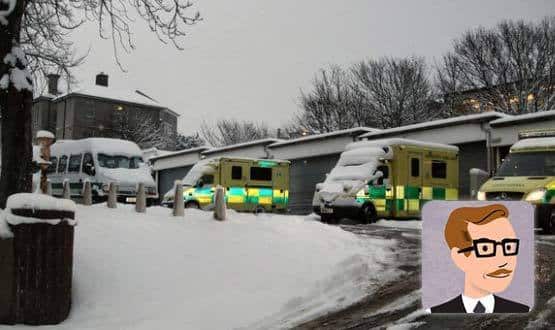For the past few winters, newspaper headlines about the NHS struggling to cope with increased demand have been as predictable as some soon-to-be-forgotten X Factor winner battling to be Christmas number one.
And this year looks no different. News organisations are already running stories about hospitals sending letters to GPs asking them not to send patients to A&E; and research from the leading healthcare think tanks suggests that a “winter crisis” is more or less “inevitable”.
The NHS’s solution has tended to be to throw money at the problem; at the start of this year, the second technology fund was raided of around £200 million to help pay for A&E support. Yet at least some organisations believe that investing in technology might be a better approach.
Intelligent use of data
Several trusts are interested in software to help them make their A&E services more efficient and able to respond to increased levels of demand.
Wrightington Wigan and Leigh NHS Foundation Trust has developed its own A&E dashboard to help it predict when are the peak times for A&E services and to make sure the appropriate level and variety of staff are available (Digital Health News will run a feature on this over Christmas).
Emis Health is also encouraging the use of a business intelligence dashboard to automate the collation and reporting of data from trust healthcare IT systems, arguing that this can free up staff time from manual reporting and support the use of predictive modelling to plan services.
Duane Lawrence, managing director of EMIS Health secondary care, says: “It is used primarily for retrospective reporting, enabling gaps in care and efficiencies to be identified. It enables healthcare professionals to predict the potential impact on services and plan to best meet demand.”
An app for A&E
Charles Lowe, chair of the Digital Health and Care Alliance and former president of the Royal Society of Medicine’s telemedicine and ehealth section council, is excited about the prospect of other new technology to enable a more productive A&E.
As an example he mentions the Mersey Burns app – which allows doctors to quickly calculate fluids for burns victims – as a tool that could save A&E staff a lot of time.
More can be done before a patient enters A&E as well, says Lowe. While an increasing number of A&E, out-of-hours and ambulance services are starting to make sure of the limited information in the NHS Summary Care Record, he mentions a tool called SOSQR.
This takes a summary of a person’s medical record and turns it into a QR code that can be set as the wallpaper on their smartphone. If that person then is involved in an accident, anyone with a QR reader can scan the phone and be linked to the care record, potentially supporting the emergency services by giving them more useful information.
Addressing demand
A lot of attention has been given to improving public education about health and alternatives to A&E, in the hope that this will reduce pressure on emergency and hospital services.
This was the main justification for the NHS Direct telephone service, which morphed into the much-criticised NHS 111, which last winter was blamed for adding to, rather than subtracting from, acute pressures, because of the supposedly risk-averse advice given by its non-medical call handlers.
The government is now trying to combine NHS Choices and NHS 111 into an nhs.uk “digital front door” for the health service. While it does so, some clinical commissioning groups and their support organisations have turned to local alternatives.
One of the most exciting is Health Help Now, an online tool and app developed by South East Commissioning Support Unit and local GPs that was launched last year.
Available in several areas in south east England, the tool provides users with information and self-management suggestions for a range of symptoms. It also has a scaled level of suggestions for local services to provide help, beginning at pharmacies and out-of-hours services and working up to 999 for the most serious cases.
Dr Chris Markwick, urgent care lead at NHS Medway CCG and clinical lead for Health Help Now in Kent and Medway, says the tool is intended as a “signposting app to help people navigate the complexity of out of hours services” with a highly localised approach.
Sophie Lyon, senior associate in communications at South East CSU, says that uptake has been very strong, with the website being used 90,000 times by more than 66,000 people in Kent where it first launched, while the app has been downloaded more than 9,000 times by people in this region.
And signs are it’s having a positive impact, says Lyon, mentioning that Medway Maritime Hospital experienced a drop in the number of minor attendances by around 10% from 2013-14 to 2014-15, while Darent Valley Hospital’s numbers fell by 28%.“It’s really difficult to show a direct link, but we think it’s really encouraging,” she adds.
Targeting may be key
Knut Schroeder, a Bristol GP and board member of the Self Care Forum, is also attempting to make self-care simpler with Expert Self Care, a planned series of apps to provide healthcare information to specific groups.
The first app is due to launch next year and is designed specifically for students, providing answers to a range of common health questions for people at university and written in collaboration with the target audience.
He’s confident that these sorts of tools can give users the confidence to treat symptoms safely themselves, provided the content is relevant and useful. “What’s really important is to prepare information in such a way so it is useful for people, it doesn’t scare them unnecessarily, and it helps them make decisions and makes them more confident.”
Telehealth makes a come-back
On the demand front, areas of the country with scattered populations – and poor weather – have naturally looked at telehealth and telecare as ways of providing alternative forms of support to blue-lighting patients into hospital.
While many, early, telehealth deployments struggled to recruit patients and win-over traditional services, there seems to be a new move to work out how this technology can be used most effectively.
So, for instance, Airedale NHS Foundation Trust has set up video links with care homes in West Yorkshire, so nurses can speak remotely to patients who may need help.
“NHS England says for anyone from a care home environment that’s accessing A&E will in 48% of cases end up being admitted. If we can stop them getting to that point then that makes a huge impact,” says Philip Parkinson, managing director of Immedicare, the joint venture between Airedale and private company Involve that sits behind the programme.
Parkinson says that in the Airedale service, experienced nurses triage patients and in 90% of cases the patient stays in their place of residence. This is very different to less focused, more consumer facing services such as NHS 111; which sees just 5% of calls end in advice on self-management.
Charles Lowe remains an advocate for this kind of approach, but says experience has taught it needs to be focused and sustained. “I can’t see any justification for the installation full bloodied telehealth purely for a month or so to deal with winter pressures; that’s got to be much more of a long-term strategy.”
Systemic change
Unfortunately, these initiatives are both relatively small scale and up against what can seem like almost insatiable demand, driven by the ageing population and an increasing burden of chronic disease.
Statistics for 2014-15 show that the NHS failed to make the 95% target for four hour waits in A&E in aggregate for the year as a whole. These aren’t just winter pressures, these are year-round pressures.
Add in the fact that around 80% of trusts are in deficit, and the government has ordered a clampdown on agency staff, who support trusts at peak times, then it does look as if it is going to be a long and bleak midwinter.
As with most issues in healthcare, the solution has to be in something bigger; perhaps growing out of creative interpretations of the government’s desire to integrate health and social care. Technology will certainly have a role to play in that. But in the meantime, it looks as if there will be a lot of copying and pasting of headlines from last year.
 | Tom MeekThomas Meek is a reporter at Digital Health News. February 2015 after spending several years writing about the pharmaceutical industry and healthcare communications, where he developed his interest in using new technologies to support patient care and education. He has a degree in journalism from The University of Stirling. Find him on Twitter at @DHTomMeek |  |

